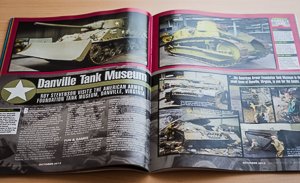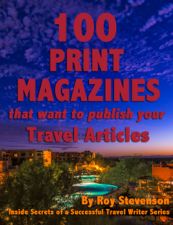- Home
- Travel Photography
How Travel Photographs
Will Help You
Sell More Stories
By Roy Stevenson
When I started out as a freelance travel writer, taking travel photographs was the furthest thing from my mind. I thought that was someone else's job. My job was to do the writing.
Sometimes this is true.
If you’re working with editors of glossy, high end, upscale magazines, like Travel & Leisure or National Geographic Travel, chances are they’ll commission professional photographers to take the shots. All you have to do is provide the copy.
But high-end glossy magazines are rarely where you start your travel writing career.
During your early years as a travel writer you’ll be writing for local or regional magazines. You might be writing for small niche magazines. And you’ll sell more stories by providing travel photographs to illustrate your article.
I estimate that you'll get published at least twice as often if you provide your own high quality photos with your travel articles.
In my first year of writing, editors would sometimes ask if I had any travel photographs to accompany my story. If I was lucky and my wife had been along on the trip, I would have her gallery of photos to offer to the editor.
After a couple of years freelancing, I'd simply pitch the editor my travel story and automatically offer a gallery of photos. And that’s how I learned about the power of providing a gallery of high-resolution photographs to accompany my articles.
Especially for travel articles, providing high quality photos is key. It turns out that most editors love writers who can provide high quality images with their articles.
Providing a photo gallery with your articles saves the editors time tracking down stock photos for the story. And, it probably also saves them money.
Having your own travel photographs enhances your story because the travel photos that you (or your spouse) made will more closely relate to your words. They’re more relevant than some random stock photos taken by a stranger at a different point in time.
As I gained more freelancing experience, I learned that some editors would only buy a story if photos accompany it. No photos, no sale.

There are also certain genres I would not have been able to break into without providing my own photos.
As an example, I write for a number of military vehicle and military history magazines. Without photos, I would not have been able to write for this genre.
And I can tell you it’s a thrill to see my military travel stories published. My stories inclued several pages with travel photographs of military vehicles and artifacts.
Be warned – sometimes you’ll spend more time taking photographs of the place than on interviews with museum curators or tour guides. In museums, especially, my photographs help me to write a more accurate and interesting story.
Travel photographs will enhance your story if done well. To be publishable, they need to be in focus and well-composed. For print media, they also need to be high resolution.
What Kind of Camera Should You Use?
Cameras have come a long way in the past few years. The majority of digital cameras on the market will provide a high enough resolution image for print media. If you’re publishing your story online, image quality is less of an issue.
For four years of my travel writing career I used a simple point-and-shoot camera. I was usually able to deliver a suitable number of images to accompany my articles.
As a novice travel writer, I didn’t want to spend a bundle of money on an expensive camera that was bulky to carry and difficult to use. And I wanted to focus primarily on my writing. When my wife was along on the trip, I relied mainly on her images to submit with my stories. She carried a dSLR camera.
But my wife doesn’t always travel with me, especially on trips that include track & field events or anything military. The day came when I needed to create higher quality photos on my own. That’s when I moved up to a dSLR.
Because a dSLR has faster responsiveness and higher quality lenses, my travel photographs improved immediately and dramatically. (dSLR = digital single lens reflex.)
With only a little training on settings available on the camera, I was able to get some excellent action photos of distance runners at track meets that came out so clearly they were worthy of publication. And the colors and clarity of my images improved thanks to newer technology and a better lens.
I’m not a techie. I shoot on automatic or use one of the pre-programmed modes. But that works fine for me. Although I still can’t use the manual settings on the camera, my travel photographs are suitable for print and that's all that matters to me.
Which camera is best for you?

Cameras comes in all shapes and sizes. They can be as small as your smart phone or the size of a full format DSLR - and everything in between.
Your camera phone is probably not going the take high enough quality photos for print magazines. I say “probably” because phone cameras have come a long way in the past couple of years. Although you might have a high level of expertise with smart phone camera techniques, I don’t recommend relying only on your smart phone if you’re pitching print.
What if you just can't be bothered taking photos?
That's where your travel companions can come in handy. You can bring along a travel companion who has a camera and will be happy to take photos. You’ll need to work together to get the right compositions and subjects, but it's a good option.
If you don't mind taking photographs, you're better off buying a decent camera and taking your own photos. That way you know you'll get shots that will fit with your story.
The easiest type of camera is a point-and-shoot. They come in every price range and have a lot of capabilities. You can get a good one for less than $500 and a great one for considerably more. They've come a long way in the past few years.
A big step up from a point and shoot is a mirrorless camera. These cameras give you the option of changing lenses so that you can get a wider range of photographs. The lens options are many and will be based on how big your budget is. A mirrorless body with a couple of good lenses can be all you need for your kit, depending upon what you photograph.
Finally, you can step up to a dSLR. If we're selling photos with an article, we typically use dSLRs so that we get the best possible image with a high quality lens. And with our dSLRs we often use a tripod for stability and to eliminate blurriness.
You might not need a dSLR at all as mirrorless camera options are available and they're usually smaller than a dSLR. We already own dSLR's and love the image quality. But next time we upgrade, we'll consider mirrorless options.
Will You Get Paid
for Your Travel Photographs?
Every magazine has their own guidelines about how they pay writers for their words. This also goes for travel photographs.
Sometimes you’ll be paid directly for your photos. And if you do get paid, one thing is certain – there’s no consistency in the amount you’ll receive from one magazine to the next.
Editors have paid me as little as $7.50 per photograph and as much as $375 for a photo, and everything in between. For some photo shoots I have been paid a set fee (for example $450) for providing a photo gallery.
Sometimes the payment is indirect. Some magazine editors pay for articles “by the page” meaning that your photographs are included with your words in your payment.
Other editors pay for half page, quarter page, or full page photo spreads, and it depends upon how they use them.
Some editors pay by the inch.
And some editors don’t pay for your photos. But this isn’t necessarily bad news. In many instances, providing photographs is the deal clincher for the editor assigning the article. No photos – no article.
So it's a package deal.
Do You Want to Sell Your Travel Story?
The question becomes: how badly do you want to sell your travel story?
Being able to provide a gallery of photos to accompany your article will result in getting published more often. I know it has garnered me hundreds of published articles over the years.
I take photos everywhere I go anyway, just to jog my memory or use as background reference material when I’m writing my story. And if some of those photos can be used with my article – it’s a bonus.
The only extra effort is to select a few and set them up on a photo gallery for the editor. I use Smugmug for my galleries and I love it. Smugmug plans currently (Jan-2022) start at $9 per month – less than the price of two capuccinos. I've been using Smugmug for about ten years. I love using it and my editors are happy because it's easy for them to view my galleries and download the photos they need. (Disclosure: if you click on one of the Smugmug links and make a purchase, I will receive a small payment. You will not pay anything extra.)
With such inconsistency about whether or not you’ll be paid for photographs, how do you know what to expect? Simple. You can usually find out by reading the magazine’s writer’s guidelines, usually found on the magazine’s website.
Once you read the guidelines, you can make an informed decision about whether or not you want to provide photos for your story.
As a writer I always enjoy seeing my work in print – as I’m sure you do, too. And when my travel photographs are professionally laid out in the magazine illustrating my story, it’s a very satisfying feeling!
Related articles that will interest you:
The Best DLSR for Travel Writers
The Best Mirrorless Cameras for Travel Writers
The Best Point and Shoot Cameras for Travel Writers
How to Get Published 90% of the Time and Make Money

Roy Stevenson is a professional travel writer and the author of www.PitchTravelWrite.com. Over the past ten years, he’s had more than 1000 articles published in 200 magazines, trade and specialty journals, in-flights, on-boards, blogs and websites and has traveled on assignment around the U.S. and to dozens of international destinations.
IF YOU ENJOYED THIS POST, GET UPDATES. IT'S FREE.














